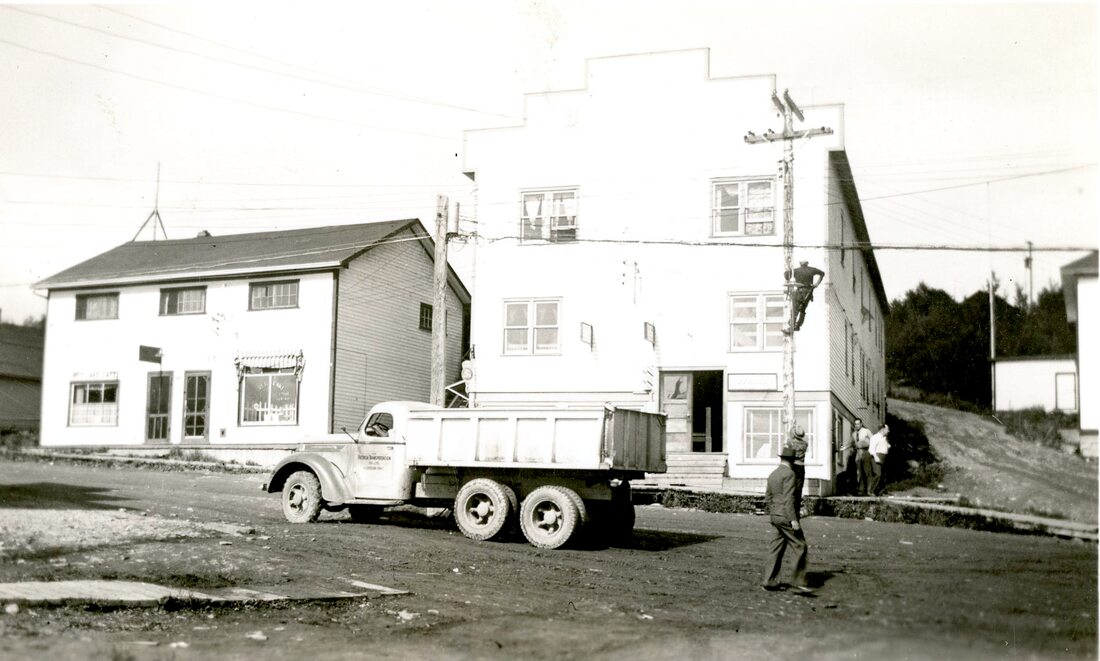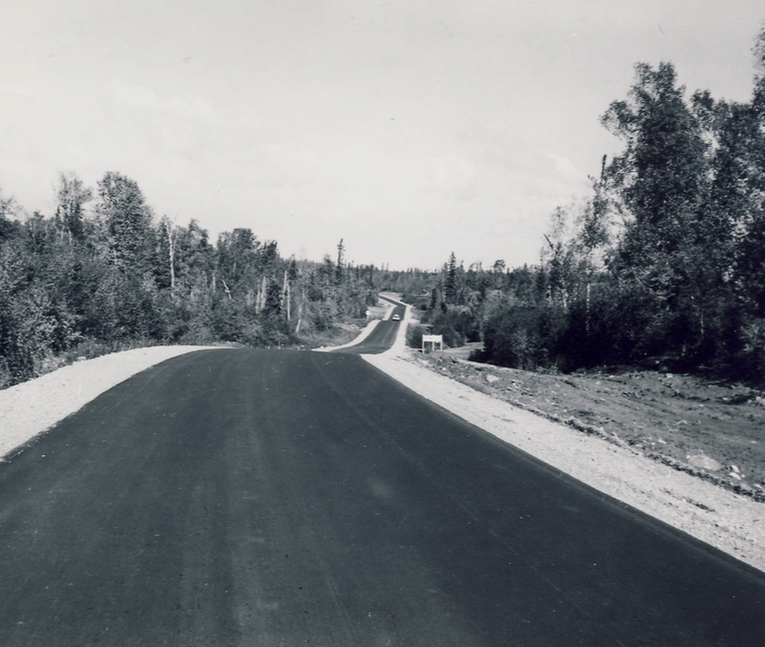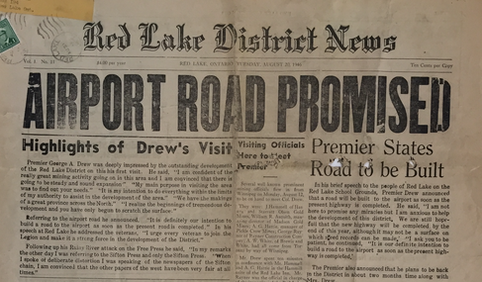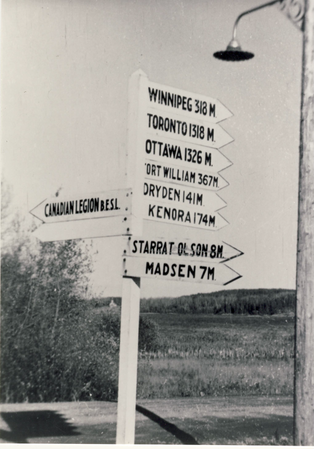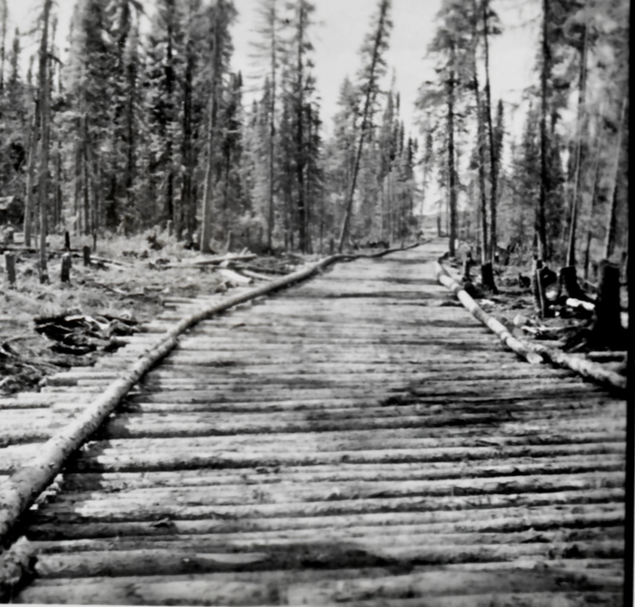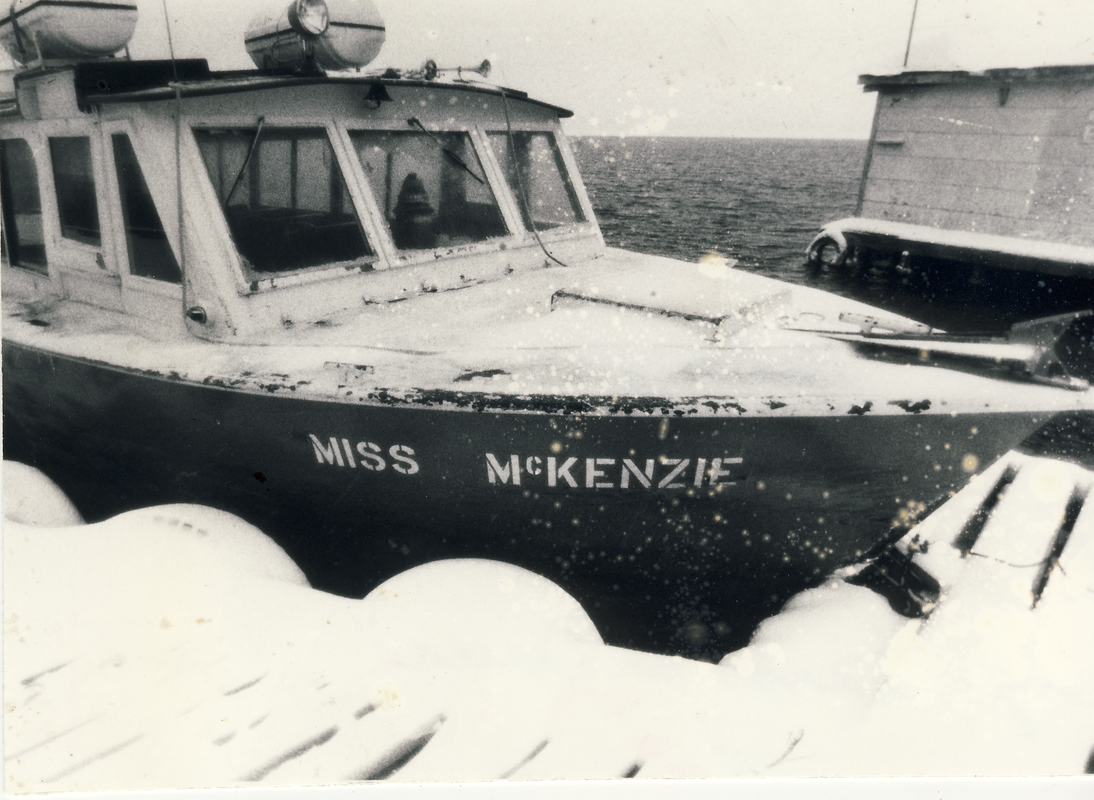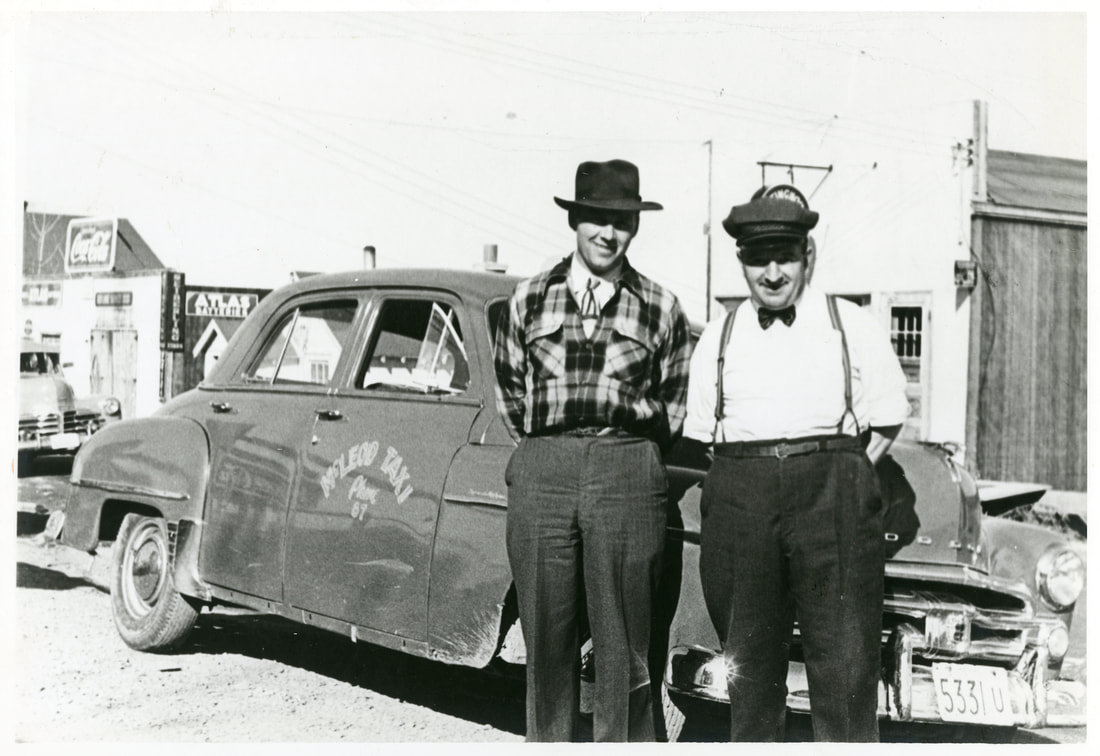Highway 105
Highway 105 sign, Kings HighwaySurveyors working on
|
In a town founded by gold mining, Red Lake was without
road access from 1926-1946. All freight and passenger transportation was by air, ice roads and boats only. For 20 years, the Government had several reasons not to build a road. Initially, Red Lake was a new gold discovery, and the Government waited to see if the area would be prosperous before making a road to such a remote area. When Howey Gold Mines started producing in 1930, the depression had started, and the Ontario Government would not put money toward a road in such a remote community. When World War II began, gold production slowed and very little left the area. In 1945 and early 1946, the community of Red Lake put pressure on the Ontario government to build a road to Red Lake. Many of the mine managers, like Jack Hammell and Ed Fahlgren and the Red Lake Chamber of Commerce, wrote letters to the Government stressing Red Lake’s need for a road. Red Lake had five producing gold mines, with three potential mines sinking shafts. By the summer of 1946, gold production would be increased with two additional mills being constructed. The Red Lake Inn hosted a public meeting about Red Lake’s need for a road in January 1946. Government representatives, mine managers and other representatives attended the meeting. One of the main issues raised was that while Red Lake was paying government taxes, it was not receiving any government services. The Ontario Government finally conceded to connect Red Lake to the rest of the province. On February 28, 1946, the Minister of Highways, George H. Doucett announced that Red Lake would get a highway. WORK BEGINS ON RED LAKE HIGHWAY, 1946NEW TIMBER BRIDGE ON RED LAKE
|
Red Lake Road sign, 1947Patricia Transportation Co. Truck driving on dirt roads in Red Lake, 1940s |
The Minister of Highways George H. Doucett drove to Red
Lake with a convoy of trucks on December 17, 1946. The Minister led the procession of trucks which included engineers, officials and a few truck drivers delivering loads to Red Lake. The Minister sent a telegram stating that it took 3 hours and 55 minutes to get to Red Lake. This may or may not have included their stop at Sam’s Portage for lunch. During the winter of 1946-47, trucks, buses and a few cars used the road, but it was not actually complete. After the snow melted, the final work on the road began. The marshy areas were drained, and the road was graveled. Highway 105 cost $3 million and was a Class “C” highway with a 7.3 metre (24-foot) wide driving surface. The grade was built to be adjusted if the steep hills and tight curves were later modified. Five bridges were constructed using local timber. In total 900 acres were cleared for the roadbed. 365,760 cubic metres (400,000 cubic yards) of earth and 205, 740 cubic metres (225,000 cubic yards) of rock were excavated. 205.7 cubic metres (225 cubic yards) of gravel was used to surface the road. |
Road Ways
|
Years before Highway 105, the individual communities
within Red Lake area had dirt roads. Cars were brought into the communities even though the streets were not the best. After Highway 105 opened, new problems began. There was an increase in traffic, caused by tourist in Red Lake. The Provincial Government refused to assist with road repairs because Red Lake was not an incorporated municipality. However, as a non-incorporated town, Red Lake had to adhere to government speed limits (48km/hour or 30m/h). Red Lake could not legally reduce the speed limits, even though residents were worried about the speed of cars. Most people walked on the streets as there were no sidewalks. Another problem was the individual communities were still not joined together by roads. Highway 618The first road between Madsen and Red Lake was mainly to transport freight and was very rough. Starting in the summer of 1937 and continuing into the winter, Patricia
Transportation Company spent $3,200 to put in a road. The road was a mix of corduroy road (log) and rock from Madsen Red Lake Gold Mines (Madsen Mine). In the fall of 1937, Madsen Mine spent $11,000 on making improvements and building a road so tractors could use the road to pull in machinery the mine needed to create the mil. By 1939, Mr. Crayston, Madsen Mine’s superintendent, was requesting more money from the Ministry of Highways to improve the road. The recommendation was for culverts, deeper ditches and rock for the road, to which the Mine offered their waste rock. The road continued to Starratt-Olsen Gold Mines (Starratt-Olsen Mine). The mines used this one-way road to bring in supplies. Although connected to the Highway 105, the road was so rough that businesses driving to Madsen and Starratt-Olsen increased their fees. Trucking companies hauling supplies to the two mines charged an additional $1/tonne to cover extra wear to their equipment and fuel used. A year later, the Patricia Transportation Company dropped this extra fee for driving the Madsen-Red Lake Road. The Pitura Brothers had a bus route on the Madsen-Red Lake Road and they also charged an additional fee for driving. The Pitura Brothers charged 55¢ for a single fare one way from Red Lake to Madsen and a $1 round trip, which was higher than the average taxi rate in the 1940s. Improvements were made to both Highway 105 and the Madsen-Red Lake Road in the 1960s. The Madsen-Red Lake Road eventually became Highway 618. Freshly paved highway 105, September 1962Red Lake District News, August 20th 1946 |
Red Lake, where traffic
|
King's Highway
|
On August 27, 1947, the highway officially opened. Ontario Premier George A. Drew and Minister of Highways George H. Doucett came to Perriault Falls for the official ceremony. Minister Doucett broke through the last barrier of the road and then “O’Canada” was played. One of the construction companies gave a bear cub to Minister Doucett for all his work on the highway. The highway not only allowed Red Lake year-round access but opened up the area to timber industry and tourism as well as further mining exploration. The mines expected to save approximately $300,000 per year on shipping costs. The road created new businesses, such as bus, taxi and trucking companies. Krons and Sons, a trucking company from Kenora, soon acquired freighting contracts and opened an office in Red Lake. The Patricia Transportation Company adapted and increased their fleet of trucks to accommodate the new way of shipping to Red Lake. These two companies earned many of the truck freighting contracts and initially charged $18/tonne for freighting to Red Lake in 1947. The rate was only $2/tonne less than the shipping rates by water. The two companies agreed it was a fair price considering the condition of the roads and the wear to their trucks. However, many in Red Lake thought the rates too high given the road was brand new. The gravel road was rough and filled with holes, causing lots of damage to cars, but people continued to use the road. The gravel road was graded, but drivers complained that within days it would be filled with holes again. With the increased traffic, the people of Red Lake started to demand a paved road. The project began in 1962 and finished in 1963. |
Premier George Drew speaking at opening
|
Taxi & Bus Service
Snowmobile Used as a Taxi
|
Before the opening of Highway 105, there were several
individual taxi and bus services. These passenger services were boats, bombardiers, tractors, buses or cars depending on the season, community or the taxi/bus routes. These early taxi and bus services would not only carry passengers but freight between the communities. Some of the taxi and bus services throughout Red Lake’s history include: Stan’s TaxiStan Demchuk operated Stan’s Taxi and drove a taxi-truck
to Madsen Red Lake Gold Mines, similar to a bus service. His wife, Mary Demchuck, said “he drove a ‘taxi-truck’ instead of a taxi car, because Red Lake then was torture for cars, as the roads were mud and sand and rocks. He took the Madsen miners who lived in Red Lake to work every day, where he was also employed.” McKenzie Island
|






